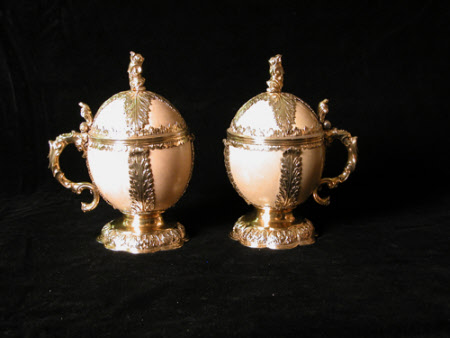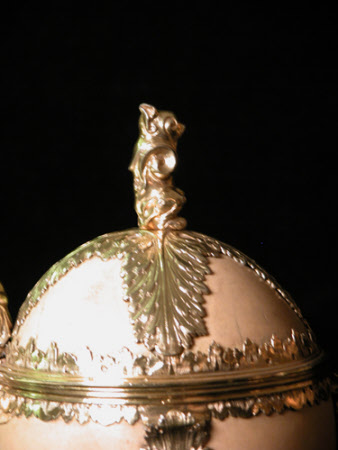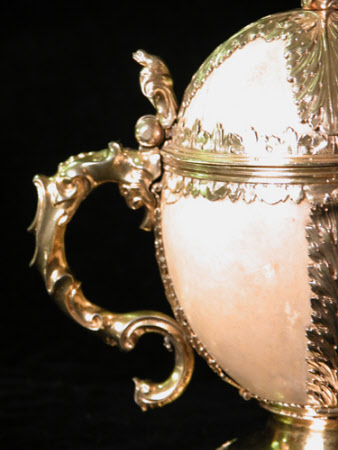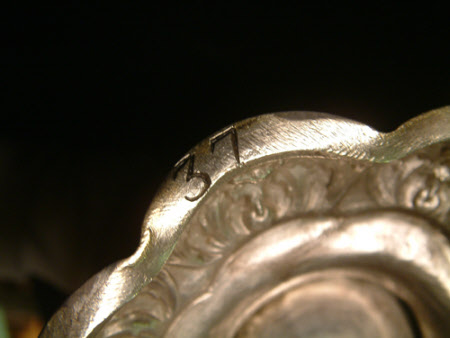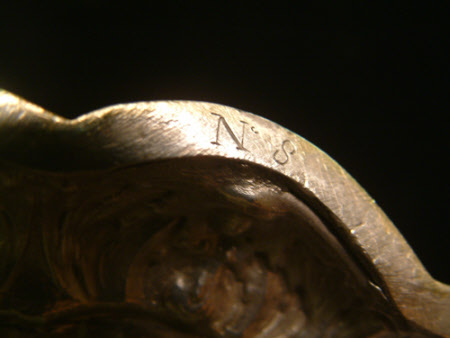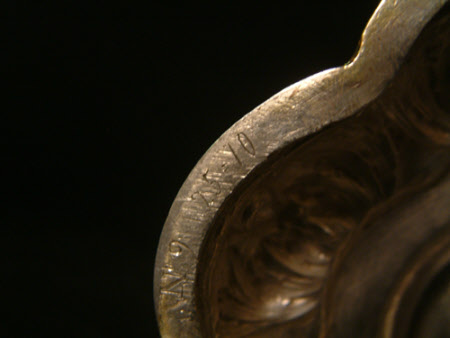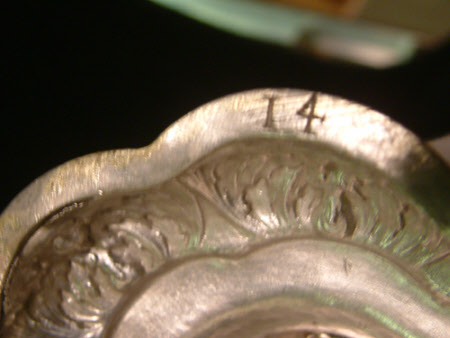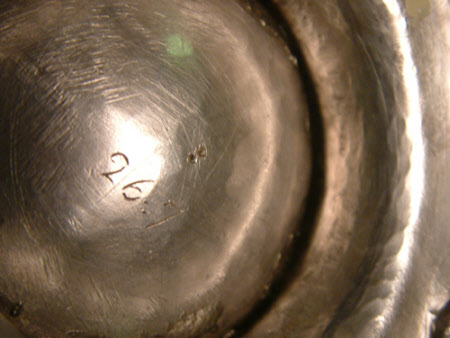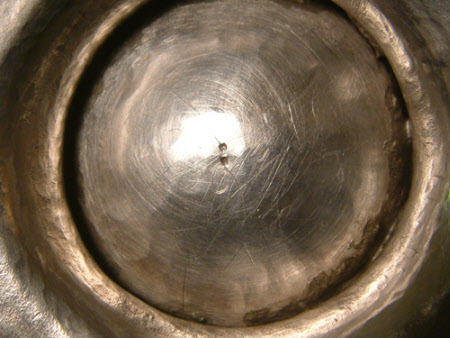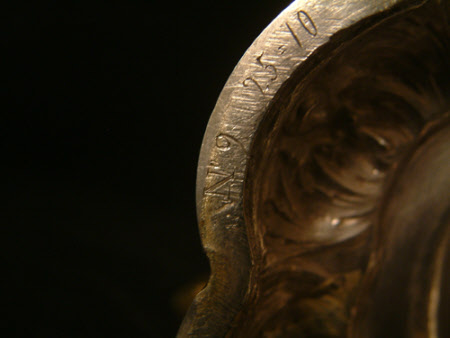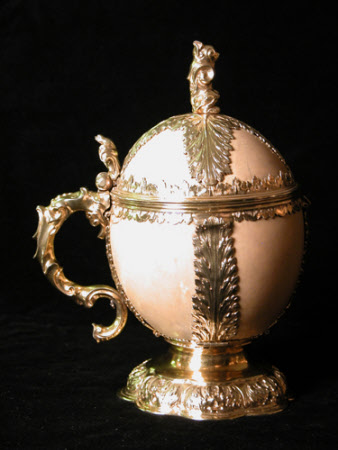Tankard
Unknown
Category
Silver
Date
1660 - 1900
Materials
Ostrich egg, silver-gilt
Measurements
24.2 x 18.7 x 14.1 cm; 1115 g (Weight)
Place of origin
Germany ?
Order this imageCollection
Anglesey Abbey, Cambridgeshire
NT 516434
Summary
A pair of ostrich egg tankards mounted in silver-gilt, unmarked, possibly with later additions and alterations; the silver-gilt feet are probably from north Germany, possibly Hamburg, circa 1670; the date and place of manufacture of the straps, finials, handles and thumbpieces are unknown, but may be from Germany, the Netherlands or England. Each ostrich egg tankard stands on a narrow foot ring soldered to a raised octofoil base, which is stepped and embossed with a border of acanthus leaves. The egg sits on an undecorated spool-shaped stem applied with a narrow border of wavy clasps. Hinges for the four straps are soldered to the mounts on both the foot and rim. The straps are finely embossed and chased with acanthus leaves. The rim of the body has a moulded border applied with a border of wavy clasps pierced with dots and engraved with a fringe. The body of the egg is not lined. The cover has a silver-gilt liner which is held on the inside by the moulded rim mount, and on the outside by a border of clasps, which are similar but more pointed than those on the body. Soldered to the cover’s mount is a narrow flange. The straps which cross over the cover are embossed with acanthus leaves to match those on the body. On top of the cover is a finial cast in the form of a squirrel, which is attached by a screw which pierces the shell and its liner and is held by a hemi-spherical nut. The bifurcated scroll thumbpiece is surmounted by a small cast frog which sits just above the prominent hinge. The S-shaped scroll handle is cast in the auricular style. Engraved on the underside of the foot on tankard 1: ‘Nᵒ 9’ and ‘37’, and on tankard 2: ‘Nᵒ 8’ and ‘14’. Hallmarks: No hallmarks or sponsor’s mark Heraldry: None Scratch weight: Tankard 1: ‘23:10’ Troy oz and pennyweights Tankard 2: ’26.7’ Troy oz and pennyweights
Full description
The ostrich egg tankards are constructed of different elements. Stylistically the parts do not form a cohesive whole; the bases look late 17th century and were probably made in Germany, whereas the straps may have been made more recently. Neither the bases nor straps ally with the auricular handles, thumbpieces, and finials, which may once have been used on another object or cast from 17th century examples. Unfortunately, the damaged eggs are too fragile to remove from their mounts. It is therefore not possible to see if the elements bear hallmarks, or to check if the current weights of the silver parts approximate the scratch weights. It would be fascinating to know more about the auricular elements. The auricular style was a development of the grotesque ornamentation of the Italian Renaissance, as used by Raphael when, in 1519, he drew inspiration from the recently discovered Roman wall paintings on the Oppian Hill for his decoration of the Vatican loggias. It bridged Mannerism and the Baroque, using lobate forms and flowing, often asymmetrical, lines to create fleshy abstract shapes, sometimes compared to the ear, mouth or genitals. The Dutch were the first to use the style in silver, naming it ‘kwab’ suggesting a flabby fold or lobe, whereas the English talked of ‘auricular’ meaning relating to the ear. The van Vianen brothers Adam (1568-1627) and Paulus (1570-1614) were the first silversmiths to fully develop the possibilities of this style by raising objects in fantastical shapes from a single sheet of silver. Their work was admired by artists and connoisseurs alike, but as most silversmiths lacked the skill to create such plasticity in metal, and the cost of the time needed to make such objects was disproportionately high, comparatively little auricular silver was produced. The style was greatly admired by Charles I – one of Britain’s greatest patrons of the arts – who invited Adam van Vianen’s son, Christian, to London in 1630. Christian returned to Utrecht, his father’s home city, during the English Civil War, but returned after the Restoration in 1660 with his son-in-law, John Cooqus, when he was appointed ‘Silversmith In Ordinary’ to Charles II. Cooqus, Jacob Bodendick, Wolfgang Howzer and others produced auricular silver, so it is possible that the unmarked handles, thumbpieces and finials were made in England. It is also possible that they were cast at a later date from Continental or English originals. Because the metal is gilded, testing would not currently show conclusively its date or place of manufacture, however, it is hoped that improved methods of detection will soon provide new information. The engraved numbers and weights on the underside of the tankards’ feet look old, however, large sets of 17th century ostrich egg cups or tankards are extremely rare, so it is unlikely that these tankards were numbers eight and nine in a set of identical tankards. It is more likely that they were the eighth and nine objects in a kunstkammer collection. Jane Ewart, 2025
Provenance
Bequeathed to the National Trust by Huttleston Rogers Broughton, 1st Lord Fairhaven (1896-1966) with the house and the rest of the contents.
Credit line
Anglesey Abbey, the Fairhaven Collection (National Trust)
Makers and roles
Unknown, goldsmith
References
Molen 2022: Johannes R. ter Molen, De zilversmeden Van Vianen en hun werk: appreciatie en tweede helft van de negentiende eeuw, Holland 2022 Truman and Shirley 2019: Charles Truman and Pippa Shirley, ‘A Rediscovered Cup by Christian van Vianen and the Collecting of Alice de Rothschild at Waddesdon Manor’, Silver Society Journal No. 35, London 2019 Baarsen 2018: Reiner Baarsen, Kwab: Ornament of Art in The Age of Rembrandt, Rijksmuseum, Amsterdam 2018 Mitchell 2017: David M. Mitchell, Silversmiths in Elizabethan and Stuart London, London 2017 Molen 1984: Johannes R. ter Molen, Van Vianen: een Utrechtse familie van zilversmeden met een internationale faam, Holland 1984 Oman 1970: Charles Oman, Caroline Silver 1625–1688, London 1970 Rothschild 1897: Ferdinand de Rothschild, Waddesdon Manor: Red Book, London 1897
